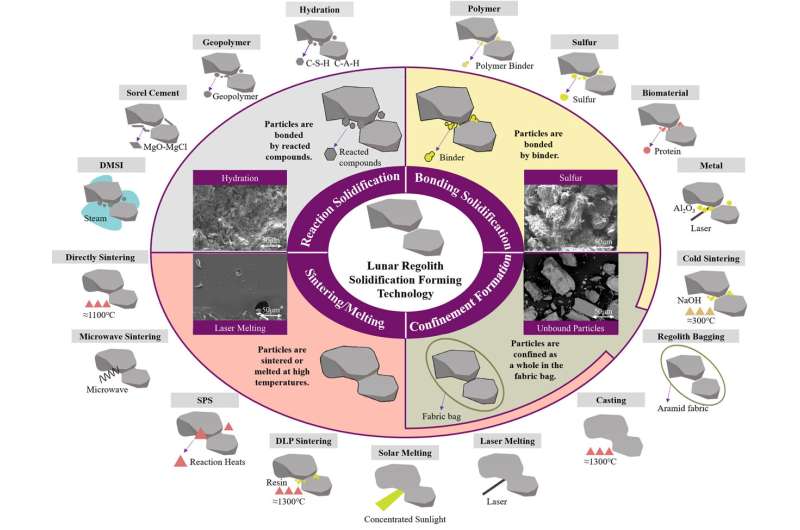Over the last few years I have been renovating my home. Building on Earth seems to be a fairly well understood process, after all we have many different materials to chose from. But what about future lunar explorers. As we head closer toward a permanent lunar base, astronauts will have very limited cargo carrying capability so will have to use local materials. On the Moon, that means relying upon the dusty lunar regolith that covers the surface. Researchers have now developed 20 different methods for creating building materials out of the stuff. They include solidification, sintering/melting, bonding solidification and confinement formation. But of all these, which is the best?
Apollo astronauts reported the surface of the Moon to be covered in a fine, powdery material, similar in texture to talcum powder. The material, known as the lunar regolith is thought to have formed by the constant bombardment from meteoroids over millions of years. The impacts bombarded the rocks on the Moon’s surface breaking them down into fine grains. The layer varies in depth across the surface from 5 metres to 10 metres and consists mostly of silicon dioxide, iron oxide, aluminium dioxide and a few other minerals. The fine nature of the dust makes it difficult for astronauts and machinery alike to operate on the surface and its sharp contours make it somewhat hazardous.

Any future engineers that visit the Moon to construct habitats will need to somehow employ the use of this material in their work. A paper published in the journal Engineering by Professor Feng from the Tsinghua University has conducted a review of possible techniques. Almost 20 techniques have been employed and these have been categorised into four main processes.
In what I can only assume to be a process similar to concrete and its reaction with water, reaction solidification takes regolith particles and reacts them with other compounds. These will have to be transported to the Moon and, when mixed with regolith, will solidify. The process would create a solid material where regolith comprises 60% to 95% of the overall mixture.
An alternative approach involves sintering or melting the regolith by subjecting it to high temperatures. The approach can create solid material composed of entirely regolith however, temperatures in excess of 1,000 degrees are required and this in itself will pose challenges and safety concerns on the lunar surface.
Bonding solidification is a process that uses other particles to bond regolith together. Similar to the reaction solidification, the result is 65% to 95% regolith in the final product. It requires lower temperatures than melting making it a safer process and it takes less time than solidification.
Finally a process known as confinement formation is an intriguing approach which uses a fabric to restrict and constrain the regolith, forming what are ultimately, bags of the stuff. This seems to be an advanced form of sand bag where the particles are not connected as they are in other processes, but still confined. 99% of the final product would be regolith and whilst it is a faster, lower temperature process, it may lack the strength of other techniques.

Finding the best approach requires consideration of cost, performance, safety, energy consumption, and resource requirements. To address the many components, the team identified the 8IMEM quantification method which includes 8 indicators. Working through the processes that have been identified, the team recommend confinement formation as the best, most cost effective and safest approach.
The confinement formation, whilst the most cost effective and fastest method may not be suitable for all construction needs. It may be suitable for some laboratory needs for example but when it comes to living quarters may not be the best. The research will help to focus and inform future decisions on construction on the Moon.
Source : Researchers quantify the ideal in situ construction method for lunar habitats


The photo caption says that NASA expects a moonbase “by 2022”. Seems overly optimistic to me.
That would seem to require some serious engineering.
Do we know–are fossil fuels potentially to be found on the moon? The notion of drilling for oil or natural gas as fuels to energize regolith into various usable products is possible. Can regolith be formed into solar panels? Imagining a large chunk of the moon creating electricity–power, 24/7 for similar purposes of regolith reformation can be a program started out small and as quickly as solar can be obtained and increased, so can the length of roads and structures.
There will be no fossil fuels on the moon; for there to be fossil fuels there needs to have been life, and it is incredibly unlikely to have ever been life on the moon.
Iranian architect Nader Khalili (1936-2008) must be looking down on this study and smiling. He studied indigenous Iranian construction, especially clay dome-like structures that were found throughout the country; he experimented with firing them to create ceramic dwellings. His vision and legacy – now being continued by CalEarth in Hesperia, California – includes packing clay into long tubes and construction domes that are simple, structurally sound and earthquake proof. He had proposed this to NASA in 1984 when they sought ideas for structures on the moon and Mars.